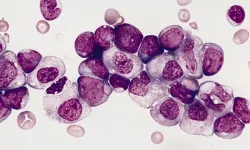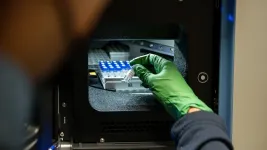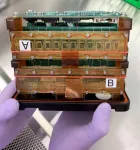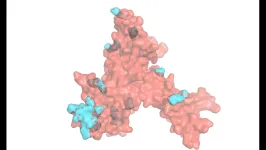(Press-News.org) Blood test identifies acute myeloid leukemia patients at greater risk for relapse after bone marrow transplant
A small portion of adults in remission from a deadly blood cancer had persisting mutations that were detected, which predicted their risk of death from having the cancer return
Researchers at the National Institutes of Health show the benefits of screening adult patients in remission from acute myeloid leukemia (AML) for residual disease before receiving a bone marrow transplant. The findings, published in JAMA, support ongoing research aimed at developing precision medicine and personalized post-transplant care for these patients.
About 20,000 adults in the United States are diagnosed each year with AML, a deadly blood cancer, and about one in three live past five years. A bone marrow transplant, which replaces unhealthy blood-forming cells with healthy cells from a donor, often improves these chances. However, research has shown that lingering traces of leukemia can make a transplant less effective.
Researchers in the current study wanted to show that screening patients in remission for evidence of low levels of leukemia using standardized genetic testing could better predict their three-year risks for relapse and survival. To do that, they used ultra-deep DNA sequencing technology to screen blood samples from 1,075 adults in remission from AML. All were preparing to have a bone marrow transplant. The study samples were provided through donations to the Center for International Blood and Marrow Transplant Research.
After screening adults with variants commonly associated with AML, researchers showed that the two most common mutations in AML – NPM1 and FLT3-ITD – could be used to track residual leukemia. Among 822 adults with these variants detectable at initial diagnosis, 142 adults – about 1 in 6 – were found to still have residual traces of these mutations after therapy despite being classified as in remission.
The researchers found the outcomes for these patients striking. Nearly 70% of patients with the lingering NPM1 and FLT3-ITD mutations relapsed and just 39% survived after three years. In comparison only 21% of adults without this evidence of trace leukemia relapsed after three years and 63% survived.
“If I’m one of six people waiting in a doctor’s office and we’re all being told we’re going in for a transplant and we’ve got the same risk, I want to know if I’m actually one of those five who has a 20% chance of relapse or if I am the one with a 70% chance of relapse,” said study lead Christopher S. Hourigan, M.D., D.Phil., senior investigator and chief of the Laboratory of Myeloid Malignancies, part of the National Heart, Lung, and Blood Institute’s (NHLBI) Intramural Program.
“Having this increased risk for relapse may not impact a person’s decision about having a bone marrow transplant, but it could influence their next steps in care,” Hourigan said. “For that one person out of six, the transplant often isn’t going to be enough. Other options might include also enrolling in a clinical research trial or considering additional or different therapies.”
“This study confirms prior research and provides new important data showing why testing for residual disease before a transplant is critical,” said Rear Admiral Richard Childs, M.D., clinical director and acting scientific director of NHLBI. “This information can also empower physicians to tailor transplant strategies, including considering different pre-transplant conditioning regimens and chemotherapies, to reduce an AML patient’s risk for relapse and improve their long-term chance for survival.”
In their analysis, the researchers also observed that adults with persistent mutations, but who were younger than age 60 and received higher doses of chemotherapy and/or radiotherapy as part of their transplant preparation, were more likely to remain cancer free after three years than those receiving lower doses.
They also found that adults who didn’t receive stronger treatment before the transplant, which is now recommended as part of clinical guidelines, did better when this lower-dose therapy included a chemotherapy drug melphalan. However, more research is needed to evaluate these potential benefits and of other treatments, including targeted therapy for the FLT3-ITD mutation.
“Finding bold and innovative approaches, including precision therapy for AML, is essential to the Biden Administration’s goal to cut the death rate from cancer in half within the next 25 years,” said James H. Doroshow, M.D., Deputy Director for Clinical and Translational Research at the National Cancer Institute (NCI).
AML accounts for 1% of all new cancer cases, and adults ages 65 and older are more likely to receive a diagnosis.
This study was funded by NHLBI, NCI, the National Institute of Allergy and Infectious Diseases, the Health Resources and Services Administration, the Office of Naval Research, and the NIH Director’s Challenge Innovation Award. The Laboratory of Myeloid Malignancies has received additional funding from Sellas and the Foundation of the NIH AML MRD Biomarkers Consortium.
To learn more about AML, visit https://www.cancer.gov/types/leukemia/patient/adult-aml-treatment-pdq and https://www.nhlbi.nih.gov/science/myeloid-malignancies.
Study: Dillon LW, Gui G, Page KM, et al. DNA sequencing to detect residual disease in adults with acute myeloid leukemia prior to hematopoietic cell transplant. JAMA. 2023; doi: 10.1001/jama.2023.1363.
###
About the National Heart, Lung, and Blood Institute (NHLBI): NHLBI is the global leader in conducting and supporting research in heart, lung, and blood diseases and sleep disorders that advances scientific knowledge, improves public health, and saves lives. For more information, visit www.nhlbi.nih.gov.
About the National Cancer Institute (NCI): NCI leads the National Cancer Program and NIH’s efforts to dramatically reduce the prevalence of cancer and improve the lives of cancer patients and their families, through research into prevention and cancer biology, the development of new interventions, and the training and mentoring of new researchers. For more information about cancer, please visit www.cancer.gov or call NCI’s contact center, the Cancer Information Service, at 1-800-4-CANCER (1-800-422-6237).
About the National Institutes of Health (NIH): NIH, the nation's medical research agency, includes 27 Institutes and Centers and is a component of the U.S. Department of Health and Human Services. NIH is the primary federal agency conducting and supporting basic, clinical, and translational medical research, and is investigating the causes, treatments, and cures for both common and rare diseases. For more information about NIH and its programs, visit www.nih.gov.
NIH...Turning Discovery Into Health
END
Blood test identifies acute myeloid leukemia patients at greater risk for relapse after bone marrow transplant
A small portion of adults in remission from a deadly blood cancer had persisting mutations that were detected, which predicted their risk of death from having the cancer return
2023-03-07
ELSE PRESS RELEASES FROM THIS DATE:
Whistleblowers losing faith in media impact
2023-03-07
The whistleblowers who once trusted journalism are losing faith in the institution.
A new study from the University of Georgia found that many whistleblowers who reached out to journalists in the past no longer believe media has the same ability to motivate change, and they feel let down by a system they once trusted.
“If you don’t believe that an outlet or journalist can carry you across the finish line—meaning can affect change, attract enough attention and attract the attention of the right people—then you’re losing faith,” said Karin Assmann, study lead and assistant professor in UGA’s Grady College of Journalism ...
STEP Demo pilot plant achieves supercritical CO2 fluid conditions
2023-03-07
SAN ANTONIO — March 7, 2023 —The Supercritical Transformational Electric Power (STEP) Demo pilot plant, a $155 million, 10-megawatt supercritical carbon dioxide (sCO2) test facility at Southwest Research Institute (SwRI) in San Antonio, developed in partnership with GTI Energy and GE Research and sponsored by the U.S. Department of Energy, has successfully achieved its first operation with CO2 at supercritical fluid conditions in its compressor section. This accomplishment represents significant progress toward ...
Splicing deregulation detected and targeted in type of childhood leukemia
2023-03-07
Pediatric acute myeloid leukemia or pAML is a childhood blood cancer, one that has proved confounding to clinicians and researchers, with a high relapse rate and relatively few identified genetic mutations (compared to the adult version) that might explain its cause.
In a new study, published in the March 7, 2023 issue of Cell Reports, an international team led by scientists and physicians at University of California San Diego School of Medicine deployed an array of analytical and gene-splicing tools to parse more deeply the mysteries of mutation in pAML.
“Compared to adult AML, pediatric AML is associated with relatively ...
Synchronizing to a beat predicts how well you get ‘in sync’ with others
2023-03-07
How well you synchronize to a simple beat predicts how well you synchronize with another mind, according to a new Dartmouth study published in Scientific Reports.
Previous work has demonstrated that the pupil dilation patterns of speakers and listeners synchronize spontaneously, illustrating shared attention. The team set out to understand how the tendency to synchronize in this way may vary at the individual level and generalize across contexts, as it has been widely debated whether one form of synchrony bears any relationship to another.
“We were ...
How high altitude changes your body’s metabolism
2023-03-07
SAN FRANCISCO, CA—March 7, 2023—Compared to those of us who live at sea level, the 2 million people worldwide who live above 4,500 meters (or 14,764 feet) of elevation—about the height of Mount Rainier, Mount Whitney, and many Colorado and Alaska peaks—have lower rates of metabolic diseases such as diabetes, coronary artery disease, hypercholesterolemia, and obesity.
Now, researchers at Gladstone Institutes have shed light on this phenomenon. They showed how chronically low oxygen levels, such as those experienced at high elevation, rewire how mice burn sugars ...
Endocrine Society elects Newell-Price as 2024-2025 President
2023-03-07
Endocrine Society members elected John Newell-Price, M.D., Ph.D., F.R.C.P., as its 2024-2025 President. He will serve as President-Elect for a year beginning in June 2023 before becoming President in June 2024.
Newell-Price is Professor of Endocrinology at the University of Sheffield in Sheffield, United Kingdom. He also is head of the endocrinology service at the Sheffield Teaching Hospitals NHS Foundation Trust and of the European Neuroendocrine Tumor Society at the hospital.
Newell-Price’s clinical expertise ...
Genetic and socioeconomic factors interact to affect risk of type 2 diabetes and obesity
2023-03-07
BOSTON – New research led by investigators at Massachusetts General Hospital (MGH), a founding member of Mass General Brigham (MGB), indicates that socioeconomic and genetic factors likely interact in an additive way to affect people’s risks of developing obesity and type 2 diabetes. The findings, which are published in Diabetes Care, suggest that interventions to improve socioeconomic deprivation may decrease metabolic diseases at the individual and community levels, especially among people with concomitant high genetic risk.
Genetic and socioeconomic factors—one intrinsic and unmodifiable and ...
Heart tissue heads to space to aid research on aging and impact of long spaceflights
2023-03-07
Note: Johns Hopkins Medicine researchers Deok-Ho Kim and Devin Mair will participate in a NASA teleconference for journalists on Tuesday, March 14, at 11 a.m. ET.
Johns Hopkins Medicine researchers are collaborating with NASA to send human heart “tissue-on-a-chip” specimens into space as early as March. The project is designed to monitor the tissue for changes in heart muscle cells’ mitochondria (their power supply) and ability to contract in low-gravity conditions.
The tissue samples will ...
Heart toggles between maintenance and energy-boost mode using ribosomes
2023-03-07
Researchers at the Centre for Genomic Regulation (CRG) in Barcelona have discovered a mechanism involving ribosomes which helps the heart toggle between a ‘regular maintenance mode’ for day-to-day function and an ‘energy-boost mode’ which aids recovery for high-demand situations including heart attacks. The findings are published in a ‘Breakthrough Article’ in the journal Nucleic Acids Research, a distinction awarded to studies that answer long-standing questions in the field.
Ribosomes are the molecular factories that manufacture proteins in all living cells. Historically, they have been ...
NYU Langone orthopedic surgeons present latest clinical findings & research at AAOS 2023
2023-03-07
Experts from NYU Langone Orthopedics will present their latest clinical findings and research discoveries at the 2023 American Academy of Orthopaedic Surgeons (AAOS) Annual Meeting, March 7 to 11, in Las Vegas.
Topics being presented include the following:
minimally invasive in-office needle arthroscopy to diagnosis and treat a common cause of chronic ankle pain
improving postoperative pain with intraoperative injections during hip fracture surgery
using an additional dose of dexamethasone to reduce postoperative opioid use for pain after knee replacement
“Our clinical teams continue to innovate and investigate how we can provide our patients with the best possible outcomes. ...
LAST 30 PRESS RELEASES:
Norbert Holtkamp appointed director of Fermi National Accelerator Laboratory
New agentic AI platform accelerates advanced optics design
Biologists discover neurons use physical signals — not electricity — to stabilize communication
Researchers discover that a hormone can access the brain by hitchhiking
University of Oklahoma researcher awarded funding to pursue AI-powered material design
Exploring how the visual system recovers following injury
Support for parents with infants at pediatric check-ups leads to better reading and math skills in elementary school
Kids’ behavioral health is a growing share of family health costs
Day & night: Cancer disrupts the brain’s natural rhythm
COVID-19 vaccination significantly reduces risk to pregnant women and baby
The role of vaccination in maternal and perinatal outcomes associated with COVID-19 in pregnancy
Mayo Clinic smartwatch system helps parents shorten and defuse children's severe tantrums early
Behavioral health spending spikes to 40% of all children’s health expenditures, nearly doubling in a decade
Digital cognitive behavioral treatment for generalized anxiety disorder
Expenditures for pediatric behavioral health care over time and estimated family financial burden
Air conditioning in nursing homes and mortality during extreme heat
The Alps to lose a record number of glaciers in the next decade
What makes a good proton conductor?
New science reporting guide published for journalists in Bulgaria
New international study reveals major survival gaps among children with cancer
New science reporting guide published for journalists in Turkey
Scientists develop a smarter mRNA therapy that knows which cells to target
Neuroanatomy-informed brain–machine hybrid intelligence for robust acoustic target detection
Eight SwRI hydrogen projects funded by ENERGYWERX
The Lundquist Institute and its start-up company Vitalex Biosciences Announces Strategic Advancement of Second-Generation fungal Vaccine VXV-01 through Phase 1 Trials under $40 Million Competitive Con
Fine particles in pollution are associated with early signs of autoimmune disease
Review article | Towards a Global Ground-Based Earth Observatory (GGBEO): Leveraging existing systems and networks
Penn and UMich create world’s smallest programmable, autonomous robots
Cleveland researchers launch first major study to address ‘hidden performance killer’ in athletes
To connect across politics, try saying what you oppose
[Press-News.org] Blood test identifies acute myeloid leukemia patients at greater risk for relapse after bone marrow transplantA small portion of adults in remission from a deadly blood cancer had persisting mutations that were detected, which predicted their risk of death from having the cancer return




